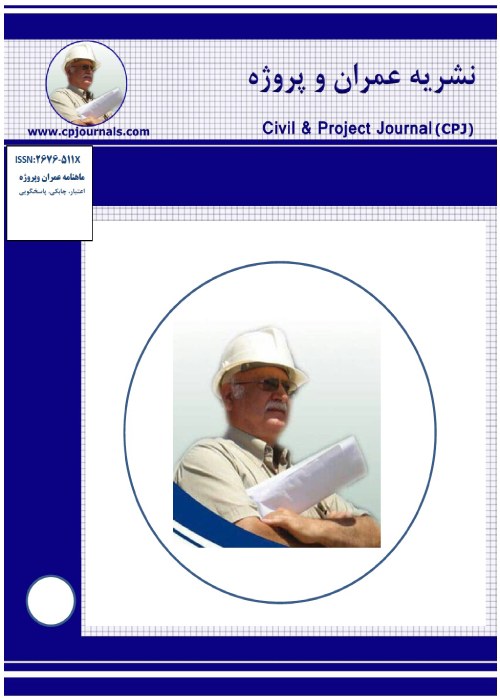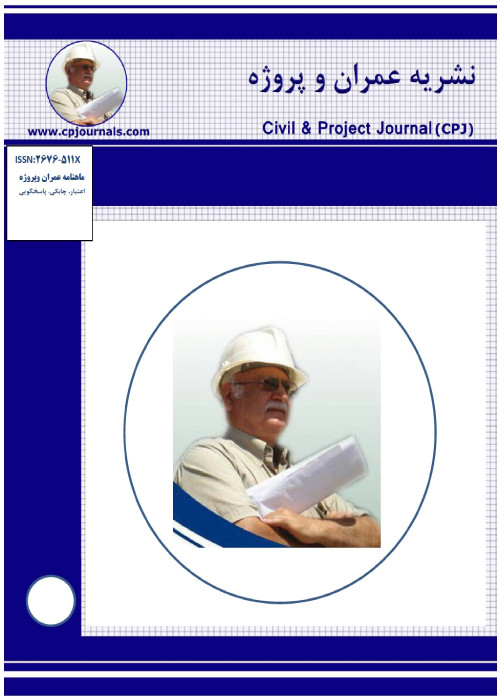فهرست مطالب

نشریه عمران و پروژه
سال چهارم شماره 8 (پیاپی 42، آبان 1401)
- تاریخ انتشار: 1401/08/24
- تعداد عناوین: 3
-
صفحات 11-29
این تحقیق با هدف ارایه مدلی جهت فشردهسازی برنامه زمانبندی با انتخاب فعالیت های بهینه از لحاظ هزینه، زمان، کیفیت و ریسک با استفاده از روش تاپسیس صورت گرفته است. پژوهش حاضر از لحاظ نتایج، کاربردی است و نتایج آن در راستای توسعه تکنیک های مدیریت پروژه و حرکت به سمت بکارگیری تکنیک های مهندسی در بهبود عملکرد سازمانهای مجری طرحهای عمرانی و سرمایه گذاری قابل استفاده است. روش های گردآوری اطلاعات در این پژوهش به دو دسته میدانی و کتابخانه ای تقسیم میشود. از روش کتابخانهای جهت جمع آوری اطلاعات مربوط به ادبیات موضوع و پیشینه پژوهش و از روش میدانی جهت گردآوری اطلاعات برای بررسی اهداف پژوهش استفاده شده است. در این پژوهش ابزار جمعآوری داده ها ابزار پرسشنامه است. جامعه آماری تحقیق برای پرسشنامه تعداد 5 نفر از خبرگان ساختمانی بخش خصوصی را شامل شده است که پرسشنامه خبرگان در میان آنها پخش شد. در یک مسیله بهینه سازی با موازنه ی زمان، هزینه، کیفیت و ریسک، روشهای اجرایی مناسب برای انجام مجموعه ی فعالیت های یک پروژه از ابتدا تا انتها باید به گونه ای انتخاب شود که عوامل زمان، هزینه، کیفیت و ریسک کل اجرای پروژه بهینه گردد. در این پژوهش برای حل مسیله از الگوریتم تاپسیس استفاده شده است.
کلیدواژگان: فشرده سازی برنامه زمانبندی، توسعه، ابزار جمع آوری داده ها، بهینه یابی، الگوریتم TOPSIS -
صفحات 30-36
با بررسی شرایط پروژه های عمرانی و هزینه های مربوط به حوادث ایمنی و بهداشت شغلی مشخص می شود که مخاطرات شغلی و مدیریت ریسک های ایمنی و بهداشت یکی از مهمترین ماموریت ها و مسوولیت های نظام مدیریت پروژه می باشد.از این رو این مطالعه با هدف ارزیابی ریسک ایمنی و بهداشت شغلی در یکی از پروژه های ساخت مرکز خرید در شهر تهران انجام شد. این پژوهش به لحاظ ماهیت یک مطالعه توصیفی - تحلیلی با رویکرد مشاهده مستقیم می باشد. نمونه در این پژوهش کلیه کارکنان پروژه به تعداد 80 نمونه بودند که به صورت هدفمند نمونه گیری و انتخاب شدند. داده ها با استفاده از فرم مدیریت ریسک به روش FMEA تجزیه و تحلیل شدند.
کلیدواژگان: مدیریت ساخت، ارزیابی ریسک، جعبه ابزار مدیریت ریسک -
صفحات 37-47بطور کلی شروع یک پروژه ساختمانی و صنعتی در مقیاس بزرگ نیازمند تهیه و تامین پیش نیازهای متعددی در سطوحمدیریت کلان و کارگاهی می باشد. در سطوح کارگاهی این پیشنیازها در قالب بسته کاری بنام تجهیز کارگاه، از زمان پیشنهاد قیمت و انعقاد قرارداد، پیش بینی گردیده و از تحویل زمین وارد فاز اجرایی می گردد. این بسته کاری تا پایان تحویل موقت و گاها تحویل قطعی (دوره تضمین) پروژه را پشتیبانی می نمایدکه بر اساس نیازها، ساختار، ماهیت و اهداف هر پروژه بصورت مستقل تعریف می گردد. در فاز اجرایی هدایت و پشتیبانی پروژه از طریق سیستم تعریف شده در تجهیز کارگاه انجام می پذیرد. بدیهی است که هر گونه اشتباه ،کوتاهی و نقصان در پیش بینی های انجام یافته جهت این فاز و عدم تطابق با الزامات و نیاز های پروژه، باعث تحمیل عقب ماندگی در زمانبندی ، هزینه مضاعف تغییرات و تحمیل فشار بر نیروی انسانی پروژه و... خواهد گردید.این تحقیق بر آن است تا با تکیه بر تجارب حاصل از پروژه های اجرا شده و مطالعات انجام یافته قبلی شیوه مدون جهت فاز تجهیز کارگاه قراردادهای EPC و پروژه های صنعتی بیان نماید.کلیدواژگان: تجهیز کارگاه، قراردادهای EPC، مکان یابی تجهیز کارگاه، ساختمانهای تجهیز کارگاه، پروژه های EPC
-
Pages 11-29
This research aims to provide a model to compress the schedule by selecting the optimal activities in terms of cost, time, quality and risk using TOPSIS method. The current research is applied in terms of results and its results can be used in the direction of developing project management techniques and moving towards the application of engineering techniques in improving the performance of organizations implementing construction and investment projects. A library is divided. The library method was used to collect information related to the subject literature and the background of the research, and the field method was used to collect information to investigate the research objectives. In this research, the data collection tool is a questionnaire. The statistical population of the research for the questionnaire included 5 construction experts from the private sector, among whom the questionnaire was distributed. In an optimization problem with balancing time, cost, quality and risk, the appropriate implementation methods for performing a set of activities of a project from the beginning to the end should be chosen in such a way that the factors of time, cost, quality and risk of the whole project implementation are optimized. In this research, TOPSIS algorithm was used to solve the problem.
Keywords: Schedule compression, developing, Data collection tool, optimization, Topsis algorithm -
Pages 30-36
By examining the conditions of construction projects and costs related to occupational health and safety incidents, it is determined that occupational hazards and the management of safety and health risks are one of the most important missions and responsibilities of the project management system. Therefore, this study aims to Occupational health and safety risk assessment was carried out in one of the shopping center construction projects in Tehran.This research is a descriptive-analytical study with a direct observation approach. The sample in this research was all project employees in the number of 80 samples, which were purposefully sampled and selected.The data were analyzed using the risk management form by the FMEA method.
Keywords: Risk Management, Risk Assessment, Risk management toolbox -
Pages 37-47In general, the start of a large-scale construction and industrial project requires the preparation and supply of several prerequisites at the management and plant in the higher levels. At the plant levels, these prerequisites are anticipated in the form of a work package called site mobilization, from the time of price proposal and contract conclusion, and it enters the implementation phase after the kick of meeting. This work package supports the project until the end of the provisional acceptance and sometimes the final acceptance (guarantee period) which is defined based on the needs, structure, nature and goals of each project. In the implementation phase, project management and support has been done through the system which has been defined in the site mobilization. It is obvious that any mistakes, lack of predictions, non-compliance with the requirements and needs of the project will cause a delay in the schedule, the cost of changes will increase and human resources will be under the pressure and etc.This research is based on the experience gained from implemented projects and previous studies to state the standardized method for the site mobilization phase of EPC contracts and industrial projects.Keywords: Site mobilization, EPC Contracts, Site mobilization location, Site mobilization buildings, EPC projects


